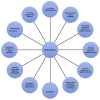Age-related hyperkyphosis: update of its potential causes and clinical impacts-narrative review
- PMID: 27538834
- PMCID: PMC5316378
- DOI: 10.1007/s40520-016-0617-3
Age-related hyperkyphosis: update of its potential causes and clinical impacts-narrative review
Abstract
The present study aims to qualitatively review the contributing factors and health implications of age-related hyperkyphosis. We conducted a narrative review of observational and cohort studies describing the risk factors and epidemiology of hyperkyphosis from 1955 to 2016 using the following key words: kyphosis, hyperkyphosis, posture, age-related hyperkyphosis, kyphotic posture, aetiology and causes. This review included 77 studies. Approximately 60-70 % of the most severe hyperkyphosis cases have no evidence of underlying vertebral compression fractures. Other proposed factors contributing to hyperkyphosis are degenerative disc disease, weakness of back extensor muscles and genetic predisposition. Strength and endurance of back extensor muscles are very important for maintaining normal postural alignment. Recent evidence suggests that age-related hyperkyphosis is not equivalent to spinal osteoporosis. Due to the negative impact of hyperkyphosis on physical function, quality of life and mortality rates, physicians should focus not only on osteoporosis, but also on age-related postural changes. More research about the relationship between spinal morphology and modifiable factors, especially the structural and functional parameters of trunk muscles, could further illuminate our understanding and treatment options for hyperkyphosis.
Keywords: Ageing; Back muscles; Hyperkyphosis; Osteoporosis; Posture.
Figures




References
-
- Fon GT, Pitt MJ, Thies AC., Jr Thoracic kyphosis: range in normal subjects. AJR Am J Roentgenol. 1980;134:979–983. - PubMed
-
- Kado DM, Prenovost K, Crandall C. Narrative review: hyperkyphosis in older persons. Ann Intern Med. 2007;147:330–338. - PubMed
-
- Schneider DL, von Muhlen D, Barrett-Connor E, et al. Kyphosis does not equal vertebral fractures: the Rancho Bernardo study. J Rheumatol. 2004;31:747–752. - PubMed
Publication types
MeSH terms
Grants and funding
LinkOut - more resources
Full Text Sources
Other Literature Sources
Medical

